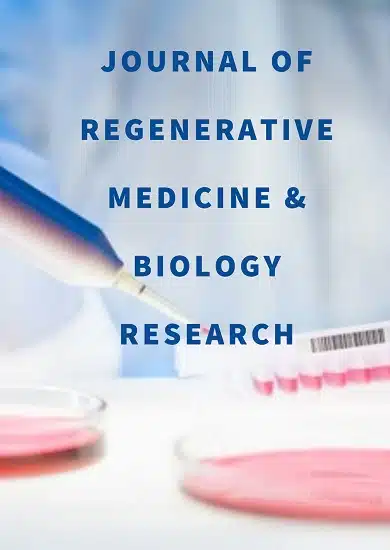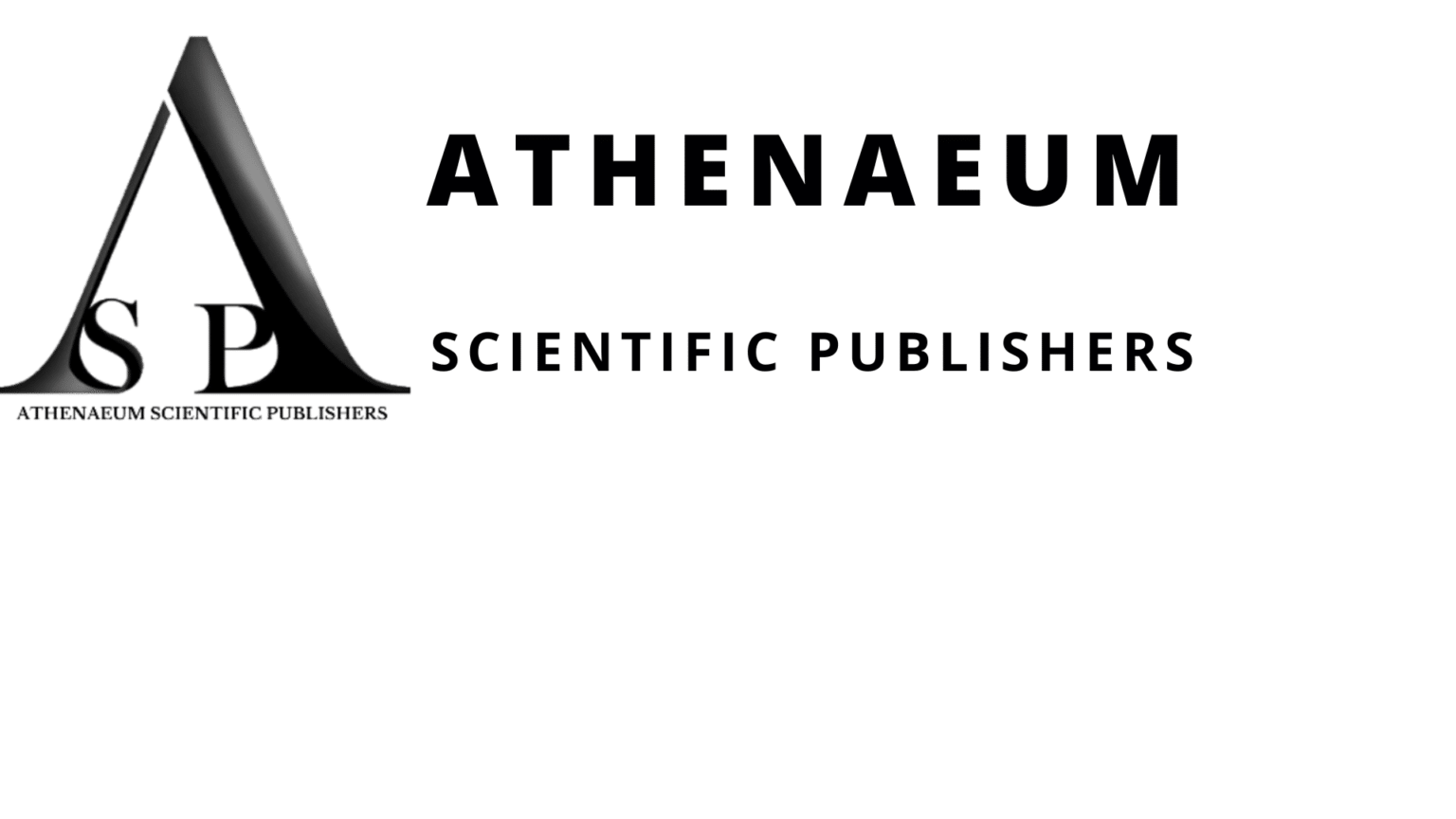Case Report | Vol. 6, Issue 1 | Journal of Regenerative Medicine and Biology Research | Open Access |
Use of Pulsed Electromagnetic Fields in Treatment of Benign Prostatic Hypertrophy: Three Case Studies
Roberta L Kline1*, Lennard M Goetze, Robert L Bard, Paul A Dreschnack
1Department of Human Nutrition and Functional Medicine, University of Western States, Portland OR, USA
*Correspondence author: Roberta L Kline, Department of Human Nutrition and Functional Medicine, University of Western States, Portland OR, USA; Email: [email protected]
Citation: Kline RL, et al. Use of Pulsed Electromagnetic Fields in Treatment of Benign Prostatic Hypertrophy: Three Case Studies. J Reg Med Biol Res. 2025;6(1):1-10.
Copyright© 2025 by Kline RL, et al. All rights reserved. This is an open access article distributed under the terms of the Creative Commons Attribution License, which permits unrestricted use, distribution, and reproduction in any medium, provided the original author and source are credited.
| Received 19 March, 2025 | Accepted 14 April, 2025 | Published 21 April, 2025 |
Abstract
Benign Prostatic Hypertrophy (BPH) is the most common benign urological condition in males. It is a progressive condition associated with aging, affecting over 80% by age 80 and can affect quality of life. While the exact cause is not fully known, hormones, metabolic alterations, inflammation and vascular flow may be contributing causes of BPH. Medical or surgical treatments are the standard of care for addressing associated Lower Urinary Tract Symptoms (LTUS) and erectile dysfunction associated with BPH, but each has risks and is not always effective.
Pulsed Electromagnetic Field (PEMF) therapy is a noninvasive modality that has been shown to address some of the potential underlying contributing factors of BPH, including inflammation and microvascularity. Ultrasound has been shown to be an effective modality to evaluate inflammatory and microvascular changes in the prostate in addition to size.
Here we present three case studies of males with known BPH and varying degrees of LTUS treated with PEMF for 30 days, utilizing ultrasound to evaluate response. Prostate size decreased in all participants, with average decrease of 27.3% and no adverse effects.
Keywords: Benign Prostatic Hypertrophy; Pulsed Electromagnetic Field; Case Study; Ultrasound
Abbreviations
BPH: Benign Prostatic Hypertrophy; LUTS: Lower Urinary Tract Symptoms; PEMF: Pulsed Electromagnetic Field; DHT: Dihydrotestosterone; AR: Androgenic Receptor; IGF-1: Insulin Growth Factor 1; TRUS: Transrectal Ultrasound; VI: Vessel Index; NOS: Nitric Oxide Synthase; NO: Nitric Oxide
Introduction
Benign Prostatic Hypertrophy (BPH) is defined as the enlargement of the prostate gland due to abnormal proliferation of stromal and epithelial cells that results in increased volume of the prostate transition zone [1]. It is a common condition of aging, estimated to affect 60% by age 60 and over 80% by age 80 [2]. Rates of BPH have been increasing over the past 30 years, affecting an estimated 79 million males over the age of 60 worldwide, especially those in China, India and the United States [3].
Symptoms are often the initiating factor for evaluation and treatment of BPH, with Lower Urinary Tract Symptoms (LUTS) affecting between 50% and 90% of males over age 50. These most commonly present as changes in urination frequency, voiding flow issues [4]. Erectile dysfunction may also be a presenting complaint. While not typically life-threatening, these symptoms can result in significant impact on quality of life.
BPH with LUTS is also costly, estimated to cost the US health care system over $4 billion a year [5], primarily due to medication and surgical treatments in addition to diagnostic procedures and office visits. This does not take into account the out-of-pocket costs nor the indirect costs to patients through loss of work and reduced quality of life.
Causes of BPH
Despite decades of research, there is still no definitive agreement on the causes of BPH. While genetics may play a small role, the etiology is most likely multifactorial. The exact molecular causes of BPH remain undefined. However, newer research highlights multiple contributing factors and biological pathways.
Hormonal
Androgens, especially the role of Dihydrotestosterone (DHT) and Androgen Receptors (AR), have been long thought to be a primary driver of BPH, but the research is mixed. Likewise, the role of estrogens on BPH is also inconsistent [6]. It is likely that, while hormones and their receptors play a significant role, there are other factors involved.
Metabolic
More recently, BPH has been linked to metabolic diseases such as metabolic syndrome, obesity and diabetes. Research has shown that insulin resistance can lead to growth of the prostate gland and development of BPH through several pathways. These include insulin and Insulin Growth Factor 1 (IGF-1), alterations in hormonal signaling, inflammation and activation of the sympathetic nervous system and potentially the renin-angiotensin system [7].
Inflammation
The role of inflammation in BPH has been further elucidated through recent studies, revealing a bidirectional influence between chronic inflammation and BPH. The REDUCE trial demonstrated that chronic inflammation was present in almost 80% of prostate biopsies in men undergoing surgery [8]. Chronic inflammation also has been associated with increased risk for development of BPH, correlates with severity of symptoms [1] and may also predict poorer response to medication treatment [9]. As a result, this is an attractive target for treating BPH.
Evaluation of BPH
BPH is typically diagnosed on digital rectal exam with additional tests as indicated. These may include PSA testing and urinary studies such as urinalysis, urodynamics and cystoscopy. Imaging by CT scan, MRI or ultrasound may also be performed as clinically indicated [10].
Transrectal Ultrasound (TRUS) has been shown to be an effective diagnostic tool to evaluate the prostate gland. Technologic advances have enabled radiologists to expand beyond evaluating prostate size to include tissue echotexture and elasticity as well as functional microvascular perfusion [11]. TRUS has also been demonstrated to be effective in identifying chronic inflammation associated with prostatitis and BPH [12].
Treatments
Treatment historically consists of medication or surgery, each of which carries risks and are not always effective. Newer, non-invasive approaches may provide additional treatment options.
Diet and Lifestyle
Diet and lifestyle changes that support reducing chronic inflammation and improving insulin regulation and other metabolic processes should be the first step in treatment for those with asymptomatic BPH, as well as those with mild symptoms. These can include Mediterranean-type diets rich in phytochemicals, fiber, lean proteins and healthy fats, while low in refined sugars [13], along with minimizing alcohol intake and stopping smoking and engaging in regular exercise, all of which have been shown to potentially help either reduce the risk, reduce progression or improve symptoms in BPH [14].
Medications
Medications are considered first-line treatment for mild to moderate BPH and its symptoms. These include alpha blockers, 5-alpha reductase inhibitors, phosphodiesterase inhibitors, anticholinergics and beta-3 agonists [2,5]. However, medications have risks of side effects and recent research has demonstrated that the elderly may be even more susceptible [2]. Given that the prevalence of BPH increases with age, this is a concern. In addition, it is challenging to predict which patients will respond to which medications. Research shows that up to 30% of patients will not respond to a given medication and may need a trial of a different medication or even surgery [5].
Surgery
The gold standard for surgical treatment remains Transurethral Resection of the Prostate (TURP), although a number of less invasive procedures have been introduced including embolization, ablation and thermal, ultrasound and cryotherapies [15]. These have been shown to have varying degrees of effectiveness and risks and often require treatment at specialized centers.
Pulsed Electromagnetic Field PEMF
Pulsed Electromagnetic Field (PEMF) Therapy is a noninvasive approach that has been shown to have biological effects that may promote healing of a variety of tissues. PEMF delivered at 1-50 Hz has been shown to reduce inflammation and tissue hypoxia [16] and has shown promise in the treatment of BPH [17-18].
Leoci, et al., demonstrated significant reduction in prostatic volume in dogs with BPH, likely due to improved blood flow [18]. Giannakopolis et al demonstrated superior results from 2 weeks of PEMF compared to 4 weeks of alpha blocker treatment for BPH with LUTS in a randomized trial. The PEMF group demonstrated improvement in prostate volume, post-void residual, urinary flow rate and IPSS scores vs improvement only in IPSS scores for the medication group [19].
Tenuta, et al., demonstrated that perineal PEMF treatment twice daily for 28 days reduced prostate size and Lower Urinary Tract Symptoms (LUTS) of BPH in a small pilot study, noting lesser effect in men with metabolic syndrome [17].
We hypothesize that PEMF affects the pathomechanism of BPH through modulation of the inflammation and microvascular flow resulting in a decreased prostate volume. Here we present three individual cases involving males diagnosed with BPH and a range of symptoms and assessed response to at-home PEMF treatments utilizing ultrasound imaging.
Case Studies
We report on three males with known BPH who received PEMF treatment, utilizing ultrasound to assess the impact of PEMF treatment on prostate size and appearance. Informed consent was obtained prior to treatment.
Ultrasound Assessment
Each individual received ultrasound imaging of the prostate gland just prior to initiation of PEMF treatment and again after 30 days of PEMF treatment.
Imaging consisted of volumetric ultrasound (GE Voluson EXPERT version 10) with 3D high resolution probes with standard prostate assessment including blood flow perfusion and presence of inflammatory microcirculation, elastography of physical characteristics to evaluate for scarring or fibrosis, evaluation for the presence of calculi and presence of any bladder pathology including calculi, tumors, postvoid residual and hypertrophy.
Treatment Protocol
The treatment regimen was designed based on previous studies that showed effectiveness at shorter treatment times with no adverse effects [17-19], plus clinical experience using PEMF for a range of inflammatory conditions that suggested longer treatment times could potentially improve response without risk of adverse effects.
Each individual was given a PEMF device to use at home (AuraWave by Aura Wellness) and instructed on proper use. To achieve perineal application, they were instructed to sit on the coil with the prostate in the center of the coil and treat twice a day for 20 minutes at a power of 9 in the am and 10 in the pm.
They were instructed to continue usual diet, lifestyle, supplements and medications as per their regular physician.
Case Study 1
77 y/o Caucasian male with increasing PSA levels and enlarging prostate on recent digital rectal exam.
Medical history significant for nonsmoker, hypercholesterolemia, glaucoma and BPH. Previous ultrasound from 1/2023 showed prostate volume 77cc.
Medications: Flomax, Lipitor, Xalatan
As per the protocol described above, a baseline ultrasound was performed followed by 30 days of at-home PEMF treatment as described per protocol above. A repeat ultrasound was then performed 1 week after completion of PEMF treatment.
Sonogram
Prostate, bladder and pelvic paraprostatic spectral Doppler vascular study was performed using transrectal 4D real time b mode examination, power Doppler, spectral flows and 3D workstation analysis (Fig. 1,2).
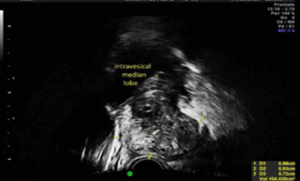
Figure 1: Ultrasound pre-treatment case study 1. Transverse view of 3D volumetric image notes prostate volume and median lobe projecting into the mid bladder region. Note the left lateral half of the gland is echo poor, indicating inflammation.
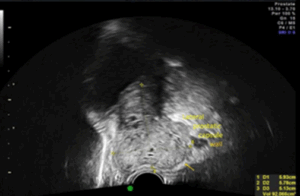
Figure 2: Ultrasound post-treatment case study 1. Post treatment view demonstrates resolution of the region back to grey echo pattern. The prostate capsule (arrow) is better outlined with the transrectal probe (peak MHz =18) making presence of any bulging or transgression (cancer if invasive or inflammatory fistula) more visible than most 3T MRI images.
Pre-Treatment Ultrasound
Prostate volume: 104 cc. Vascular area noted right lateral prostate measuring 9×7 mm, VI = 1% no suspicious characteristics. (Vessel Index (VI) is a quantitative measure of inflammatory or malignant vessels.) Scattered calculi noted, no evidence of malignant pattern.
Post-Treatment Ultrasound
Prostate volume: 92 cc. No change in vascular area, VI or calculi.
Prostate volume comparison: Reduction of 12 cc = 11.5% decrease
Case Study 2
87 y/o Caucasian male for follow-up evaluation of stable BPH.
Medical history significant for nonsmoker, hypercholesterolemia, hypertension and BPH. Previous ultrasound from 1/2023 showed prostate volume 40 cc (Fig. 3,4).
Medications: Amlodipine besylate, aspirin, atorvastatin, carvedilol, irbesartan-hydroclorothiazide.
As per the protocol described above, a baseline ultrasound was performed followed by 30 days of at-home PEMF treatment as described per protocol above. A repeat ultrasound was then performed 1 week after completion of PEMF treatment.
Sonogram
Prostate, bladder and pelvic paraprostatic spectral Doppler vascular study was performed using transrectal 4D real time b mode examination, power Doppler, spectral flows and 3D workstation analysis.
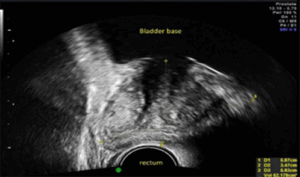
Figure 3: Ultrasound pre-treatment case 2. Pretreatment transverse image (slice of 95 obtained during 10 second scan) shows echo poor region at prostate anterior and apical segment. 3D or 4D (3D in real time) is operator independent due to a phased array probe that remains fixed during the scan.
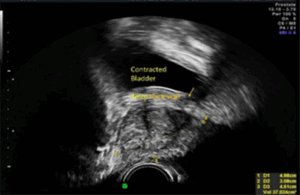
Figure 4: Ultrasound post-treatment case 2. Note the reduction of low amplitude echoes post therapy and the clear imaging of the bladder wall thickness. Pre and post void volumes are quickly measured if needed. All pretreatment imaging involves evaluating the bladder wall for cancer. 3D Doppler permits evaluation of invasive tumors that may be confirmed on MRI.
Pre-Treatment Ultrasound
Prostate volume: 62 cc. Volume measurements of the gland are influenced by bladder wall thickness as the tissues are adjacent, but the use of 3D multiplanar real time imaging permits clear delineation of these structures. No evidence of malignant characteristics.
Post-Treatment Ultrasound
Prostate volume: 37 cc. No change in appearance or characteristics previously noted.
Prostate volume comparison: reduction of 25 cc = 40.3% decrease.
Case Study 3
66 y/o Caucasian male with known BPH for increasing prostate size on digital rectal exam.
Medical history significant for BPH, S/P laser of prostate 6 months ago. Previous ultrasound from 1 year ago showed prostate volume 103 cc (Fig. 5,6).
Medications: None
As per the protocol described above, a baseline ultrasound was performed followed by 30 days of at-home PEMF treatment as described per protocol above. A repeat ultrasound was then performed 1 week after completion of PEMF treatment.
Sonogram
Prostate, bladder and pelvic paraprostatic spectral Doppler vascular study was performed using transrectal 4D real time b mode examination, power Doppler, spectral flows and 3D workstation analysis.
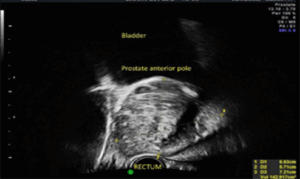
Figure 5: Ultrasound pre-treatment case study 3. Transverse view for volume shows artifactual sonic shadowing (dark areas) related to fibrosis and/or macrocalcific areas. Multiple angles during imaging including transperineal scans avoid diagnostic interpretation issues. The 3D probe has advanced microvascular imaging that measures inflammation and abscess formations (when present).
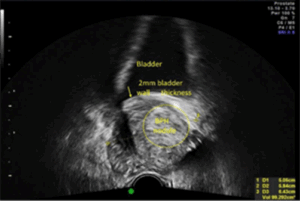
Figure 6: Ultrasound post-treatment case study 3. Post treatment with reduced tissue density permits identification of a focal benign midgland nodule that is non palpable and is well demarcated during the follow up scan. Bladder wall thickness is 2 mm and within normal range.
Pre-Treatment Ultrasound
Prostate volume: 143 cc. Scattered calculi noted, no evidence malignant pattern.
Post-Treatment Ultrasound
Prostate volume: 100 cc. No change in calculi. New 2 cm echogenic benign prostate nodule noted.
Prostate volume comparison: Reduction of 43 cc = 30.0% decrease
Results
All participants successfully completed treatment and no adverse effects were reported. Variable volume loss was reported, ranging from 11.5% to 40.3%, with an average decrease of 27.3%. No development of abnormal findings indicating progression or suspicion of malignancy was noted.
The patient for Case Study 2 had the largest volume reduction of the prostate gland at 40.3%. It is noteworthy that the 30-day PEMF treatment reduced the prostate volume from 62 cc to to 37 cc. This was not only less than his initial ultrasound but also from an ultrasound done 6 months previously (40 cc).
The patient for Case Study 3 had been previously treated with laser less than 6 months prior to the initial ultrasound. Despite this treatment, his prostate size at the initial ultrasound had increased from 103 cc to 143 cc. The 30-day treatment with PEMF reduced the prostate size by 30% to 100 cc, 3 cc less than prior to the laser treatment. With the decrease in prostate size, a new benign prostate nodule was noted. It is unclear as to whether this was present but not detected at the first ultrasound or it is a new development.
The patient for Case Study 1 had the smallest volume reduction of the prostate gland, from 104 cc to 92 cc, a decrease of 11.5%. Note that his initial ultrasound had documented growth in prostate volume from a scan 6 months prior from 77 cc to 104 cc, which then decreased in size to 92 cc over 30 days with the PEMF treatment. He also had a vascular area that appeared benign on initial scan and no change in the vascular index after the treatment.
Discussion
The study of the physical properties of a cell’s molecules that target immune modulation and regenerative medicine have not been the focus of significant scientific research [20]. However, findings over the last decade suggest that low-frequency PEMF exposure therapy alters the biophysical characteristics of highly ordered elements at all levels of physiology (cells, tissue, organs, systems) [20]. As a result, PEMF can induce changes in cell proliferation, alterations in membrane structure and function, nucleic acids, protein and Adenosine Triphosphate (ATP) synthesis [20].
PEMF Mechanisms of Action
PEMF utilizes pulsed electromagnetic fields to induce biological effects on cells and tissues. Its effects occur through three main mechanisms of action.
The first is induction of transient depolarization of the plasma membrane, leading to influx of Ca2+ via voltage-dependent Ca2+ ion channels. The second is the production of Nitric Oxide (NO), triggered by the binding of calcium to calmodulin [21] These both occur within seconds of application of the PEMF.
The third mechanism is the activation of gene transcription across numerous cell-signaling pathways. This occurs within hours to days and likely accounts for longer-term healing processes. Gene transcription is initiated indirectly through the Ca2+ induced NO pathway described above, as well as through direct activation of numerous cell-signaling pathways [21].
Wang, et al., demonstrated direct activation of the CGRP, Wnts, TGF-a, BMP, IGF, PTH and NOTCH pathways, leading to altered gene expression in osteoblasts [22]. Studies by Ross, et al., and Hu, et al., evaluated the use of PEMF in patients with inflammatory MSK disorders and Rheumatoid Arthritis, both noting altered gene transcription as a result of multiple cell-signaling activations, including in the RANKL/RANK, TRK and A2A and A3 receptor pathways [20,23]. These resulted in downregulation of proinflammatory genes including PGE2, TNF-a and NF-κB with simultaneous upregulation of the antioxidant pathways via NFE2L2, leading to altered oxidative stress and inflammatory responses, cell cycle, growth, apoptosis, mitochondrial function and biogenesis [20,23].
In a recent study by Panja, et al., they documented changes in gene expression across multiple pathways after an LPS-induced inflammatory response followed by a single PEMF session that would support anti-inflammatory and cell regenerative effects [24].
The Impact of PEMF on the Prostate
Recently, the usage of PEMF to modulate cell signaling pathways that involve inflammation has become an innovative alternative treatment [20], including for disorders of the prostate gland.
In prostate cancer, nuclear factor kappa-light-chain-enhancer of activated B cells (NF-kB) transcription factor plays an essential role in overall progression of a tumor by influencing proliferation, increased resistance to cell-death (apoptosis) and androgen receptor expression alterations [25]. NF-kB activates numerous genes that regulate innate and adaptive immune responses by increasing the production of cytokines, chemokines and adhesion molecules [26]. Also, other intracellular and extracellular vesicles regulate apoptosis, differentiation, morphogenesis (angiogenesis) and cell survival [26]. An experimental study that was done on mouse myoblast-stem cell culture (skeletal muscle cell precursor) expressing NF-kB that were treated with a PEMF protocol showed a significant reduction of NF-kB expression and increased expression of the NF-kB inhibitor alpha gene [27]. The empirical data highlight the critical role of a deregulated NF-kB activation in pathogenic processes/inflammation such as BPH and the development of therapeutic strategies targeting NF-kB inhibition [26].
Studies suggest that altered Nitric Oxide Synthase (NOS) expression contributes to the pathogenesis of BPH [18]. Theoretically, Nitric Oxide (NO) secretion is a strong promoter of micro-vessel dilatation [18]. Data shows that PEMF stimulatory effects were mediated by the increase in NO synthesis [18]. Low levels of NOS expression in BPH tissue, compared with higher levels in atrophic tissue, support the claim that NOS expression is downregulated in the prostate with benign cellular proliferation [18].
In reviewing the clinical evidence of these case studies and the theoretical approach related to the BPH pathomechanisms, we suggest that PEMF therapy could regulate inflammatory processes and microvascular flow in the gland. This event would restore tissue homeostasis. Theoretically, PEMF can modulate cell surface receptor expression and activate multiple intracellular pathways that influence events such as proliferation, differentiation and cell-cell communication through the release of extracellular vesicles [20].
We believe that PEMF may also play a significant role in regulating the ratios of stem cells within the prostate tissue itself. By influencing cellular dynamics, PEMF may contribute to maintaining a balanced stem cell population, which is crucial for tissue homeostasis and regeneration. This regulation could be particularly relevant in both normal physiological conditions and pathological states, where disruptions in stem cell ratios may lead to abnormal tissue development or disease progression. However, further research is needed to elucidate the precise mechanisms through which PEMF exerts its effects on stem cell behavior within the prostate.
Many traditional therapies utilized for BPH appear not to have a positive outcome on such pathology. Based on the observational and clinical data of this case study series, we suggest that PEMF therapy could be contributory to the resolution of such a condition.
Conclusion
BPH affects a significant percentage of males, especially as they age. Because this condition is progressive, intervening at earlier stages could provide not only relief of symptoms but potentially prevent more severe disease and retain better quality of life. Finding effective treatments that are noninvasive and easily accessible may provide better alternatives than currently accepted treatment options.
This case study series supports previous research showing that PEMF is effective for the treatment of mild BPH and associated LUTS, is well-tolerated without significant side effects and can be easily implemented as standard treatment for these patients. The variable results are not unexpected and can be due to individual responses to the same treatment protocols.
Portable and requiring minimal patient training, PEMF has the potential advantage of home treatment, making it a more convenient option for early intervention that is accessible to a wider range of patients, especially the disabled and elderly.
One of the challenges in current PEMF research is the lack of standardized protocols, so optimal treatment strategies have not been defined. Future research should focus on standardizing the effective treatment dosage and duration for BPH, including whether long-term usage provides continued benefit. Evaluation of gene expression would also be valuable to elucidate the mechanisms of action in the treatment of BPH.
Conflict of Interest
The authors report no conflicts of interest.
Funding
The AngioFoundation and Aura Wellness LLC provided unrestricted funding and Aura Wellness LLC for providing PEMF devices at no cost to the patients or physician.
Author’s Contributions
RLK drafted the manuscript and approved the final version; RLB was principal investigator and contributed to the manuscript; LMG conceived and designed the research and contributed to the manuscript; and PAD edited and revised the manuscript.
Consent to Participate
Written informed consent was obtained from each patient prior to treatment and is permanently attached to each patient’s chart. Copies of the informed consent and treatment protocol were provided to each patient prior to participation.
Consent for Publication
Written informed consent for publication of clinical details and images was obtained from each patient prior to participation.
References
- Cao D, Sun R, Peng L, Li J, Huang Y, Chen Z, et al. Immune cell proinflammatory microenvironment and androgen-related metabolic regulation during benign prostatic hyperplasia in aging. Front Immunol. 2022;13:842008.
- Miernik A, Gratzke C. Current treatment for benign prostatic hyperplasia. Deutsches Ärzteblatt Int. 2020;117(49):843.
- Ye Z, Wang J, Xiao Y, Luo J, Xu L, Chen Z. Global burden of benign prostatic hyperplasia in males aged 60–90 years from 1990 to 2019: Results from the global burden of disease study 2019. BMC Urology. 2024;24(1):193.
- Lerner LB, McVary KT, Barry MJ, Bixler BR, Dahm P, Das AK, et al. Management of lower urinary tract symptoms attributed to benign prostatic hyperplasia: AUA guideline part I-initial work-up and medical management. The Journal of Urology. 2021;206(4):806-17.
- Wang Z, Olumi AF. Metformin: An antiproliferative agent and methylation regulator in treating prostatic disease? Am J Physiology-Renal Physiology. 2018;314(3):F407-11.
- Devlin CM, Simms MS, Maitland NJ. Benign prostatic hyperplasia–what do we know? BJU International. 2021;127(4):389-99.
- Fu X, Wang Y, Lu Y, Liu J, Li H. Association between metabolic syndrome and benign prostatic hyperplasia: The underlying molecular connection. Life Sciences. 2024:123192.
- Andriole G, Bostwick D, Brawley O, Gomella L, Marberger M, Tindall D, et al. Chemoprevention of prostate cancer in men at high risk: rationale and design of the Reduction by Dutasteride Of Prostate Cancer Events (REDUCE) trial. The Journal of Urology. 2004;172(4 Part 1):1314-7.
- Gandaglia G, Briganti A, Gontero P, Mondaini N, Novara G, Salonia A, et al. The role of chronic prostatic inflammation in the pathogenesis and progression of Benign Prostatic Hyperplasia (BPH). BJU International. 2013;15;112(4).
- Ng M, Leslie SW, Baradhi KM. Benign prostatic hyperplasia. StatPearls Publishing. 2025.
- Ahmed R, Hamdy O, Awad RM. Diagnostic efficacy of systemic immune-inflammation biomarkers in benign prostatic hyperplasia using receiver operating characteristic and artificial neural network. Scientific Reports. 2023;13(1):14801.
- Lee HJ, Choe GY, Seong CG, Kim SH. Hypoechoic rim of chronically inflamed prostate, as seen at TRUS: Histopathologic findings. Korean J Radiol. 2001;2(3):159-63.
- Mousavi SN, Nouri M, Yousefi Rad E, Kazemi R, Birjandi M, Coe S, et al. Association between dietary phytochemical index and risk of benign prostatic hyperplasia: a case-control study. Journal of Health, Population and Nutrition. 2024;43(1):35.
- Kristal AR, Arnold KB, Schenk JM, Neuhouser ML, Goodman P, Penson DF, et al. Dietary patterns, supplement use and the risk of symptomatic benign prostatic hyperplasia: results from the prostate cancer prevention trial. Am J Epidemiol. 2008;167(8):925-34.
- Sciacqua LV, Vanzulli A, Di Meo R, Pellegrino G, Lavorato R, Vitale G, et al. Minimally invasive treatment in Benign Prostatic Hyperplasia (BPH). Technology in Cancer Research and Treatment. 2023;22:15330338231155000.
- Strauch B, Herman C, Dabb R, Ignarro LJ, Pilla AA. Evidence-based use of pulsed electromagnetic field therapy in clinical plastic surgery. Aesthetic Surgery J. 2009;29(2):135-43.
- Tenuta M, Tarsitano MG, Mazzotta P, Lucchini L, Sesti F, Fattorini G, et al. Therapeutic use of pulsed electromagnetic field therapy reduces prostate volume and lower urinary tract symptoms in benign prostatic hyperplasia. Andrology. 2020;8(5):1076-85.
- Leoci R, Aiudi G, Silvestre F, Lissner E, Lacalandra GM. Effect of pulsed electromagnetic field therapy on prostate volume and vascularity in the treatment of benign prostatic hyperplasia: A pilot study in a canine model. The Prostate. 2014;74(11):1132-41.
- Giannakopoulos XK, Giotis C, Karkabounas SC, Verginadis II, Simos YV, Peschos D, et al. Effects of pulsed electromagnetic fields on benign prostate hyperplasia. Int Urology and Nephrology. 2011;43:955-60.
- Ross CL, Ang DC, Almeida-Porada G. Targeting Mesenchymal Stromal Cells/pericytes (MSCs) with Pulsed Electromagnetic Field (PEMF) has the potential to treat rheumatoid arthritis. Front Immunol. 2019;10:266.
- Luigi C, Tiziano P. Mechanisms of action and effects of Pulsed Electromagnetic Fields (PEMF) in medicine. J Med Res Surg. 2020;1(6):1-4.
- Wang A, Ma X, Bian J, Jiao Z, Zhu Q, Wang P, et al. Signalling pathways underlying pulsed electromagnetic fields in bone repair. Front Bioengineering and Biotechnology. 2024;12:1333566.
- Hu H, Yang W, Zeng Q, Chen W, Zhu Y, Liu W, et al. Promising application of Pulsed Electromagnetic Fields (PEMFs) in musculoskeletal disorders. Biomedicine and Pharmacotherapy. 2020;131:110767.
- Panja A, Binder R, Binder S. Focused‑pulsed electromagnetic field treatment reverses lipopolysaccharide‑induced alterations in gene expression profile in human gastrointestinal epithelial cells. Int J Health and Allied Sci. 2021;10(1):55.
- Staal J, Beyaert R. Inflammation and NF-κB signaling in prostate cancer: Mechanisms and clinical implications. Cells. 2018;7(9):122.
- Liu T, Zhang L, Joo D, Sun SC. NF-κB signaling in inflammation. Signal transduction and targeted therapy. 2017;2(1):1-9.
- Ross CL, Zhou Y, McCall CE, Soker S, Criswell TL. The use of pulsed electromagnetic field to modulate inflammation and improve tissue regeneration: A review. Bioelectricity. 2019;1(4):247-59.
Author Info
Roberta L Kline1*, Lennard M Goetze, Robert L Bard, Paul A Dreschnack
1Department of Human Nutrition and Functional Medicine, University of Western States, Portland OR, USA
*Correspondence author: Roberta L Kline, Department of Human Nutrition and Functional Medicine, University of Western States, Portland OR, USA;
Email: [email protected]
Copyright
Roberta L Kline1*, Lennard M Goetze, Robert L Bard, Paul A Dreschnack
1Department of Human Nutrition and Functional Medicine, University of Western States, Portland OR, USA
*Correspondence author: Roberta L Kline, Department of Human Nutrition and Functional Medicine, University of Western States, Portland OR, USA;
Email: [email protected]
Copyright© 2025 by Kline RL, et al. All rights reserved. This is an open access article distributed under the terms of the Creative Commons Attribution License, which permits unrestricted use, distribution, and reproduction in any medium, provided the original author and source are credited.
Citation
Citation: Kline RL, et al. Use of Pulsed Electromagnetic Fields in Treatment of Benign Prostatic Hypertrophy: Three Case Studies. J Reg Med Biol Res. 2025;6(1):1-10.

